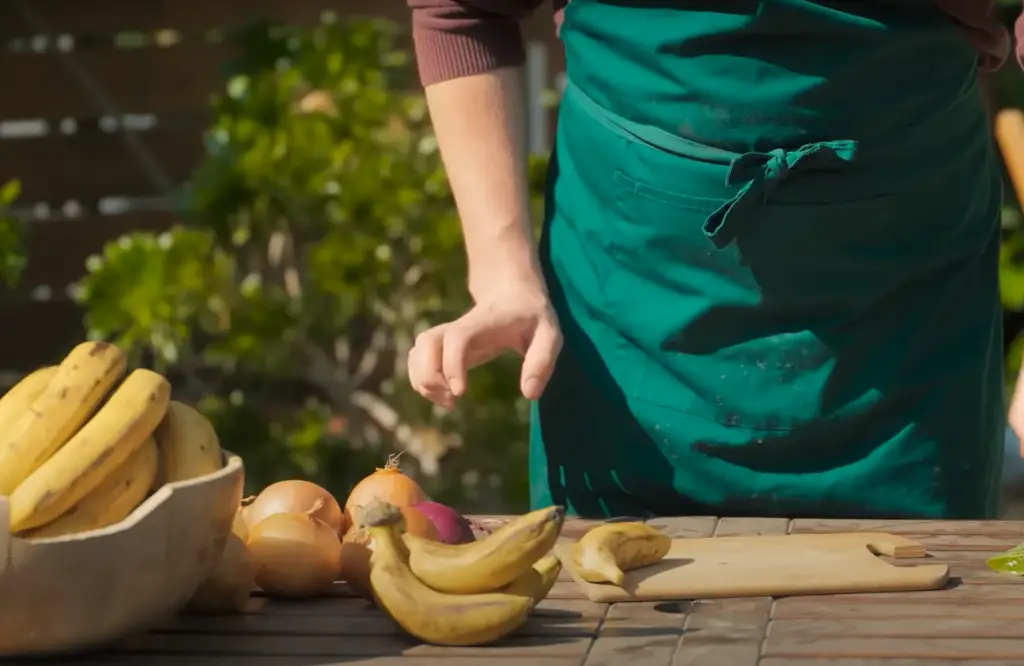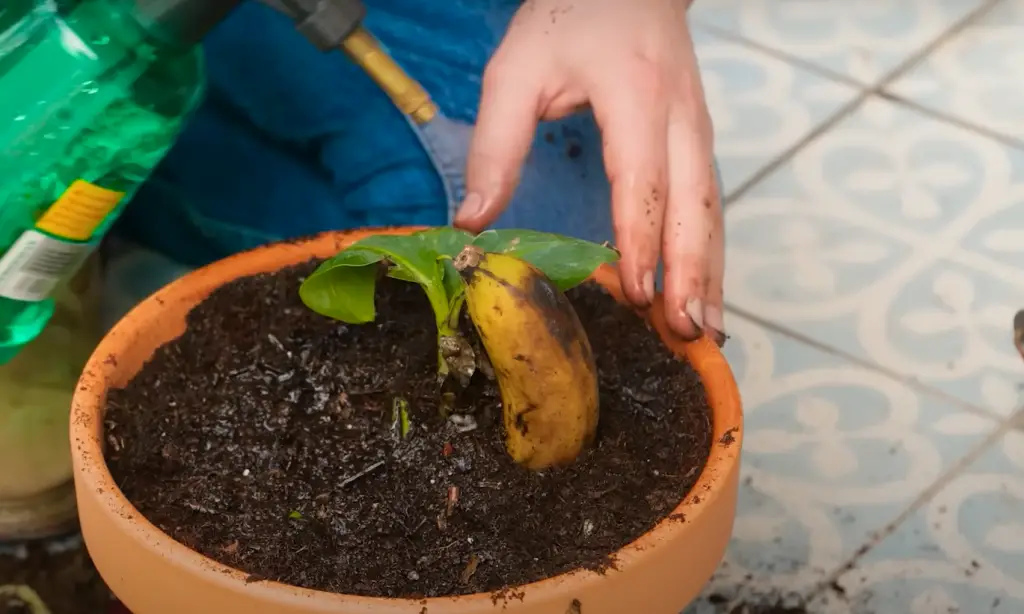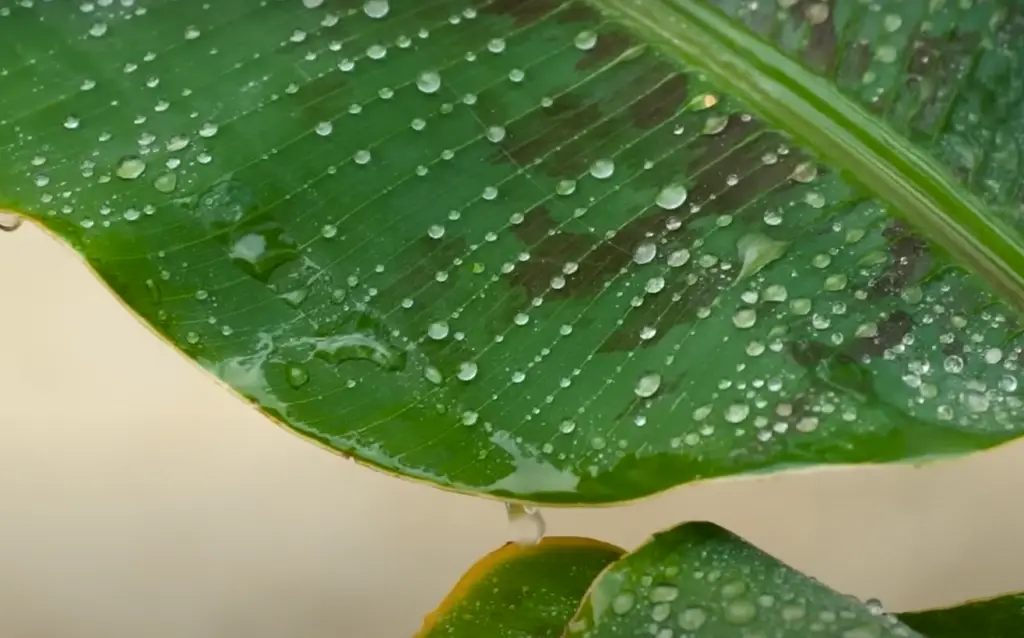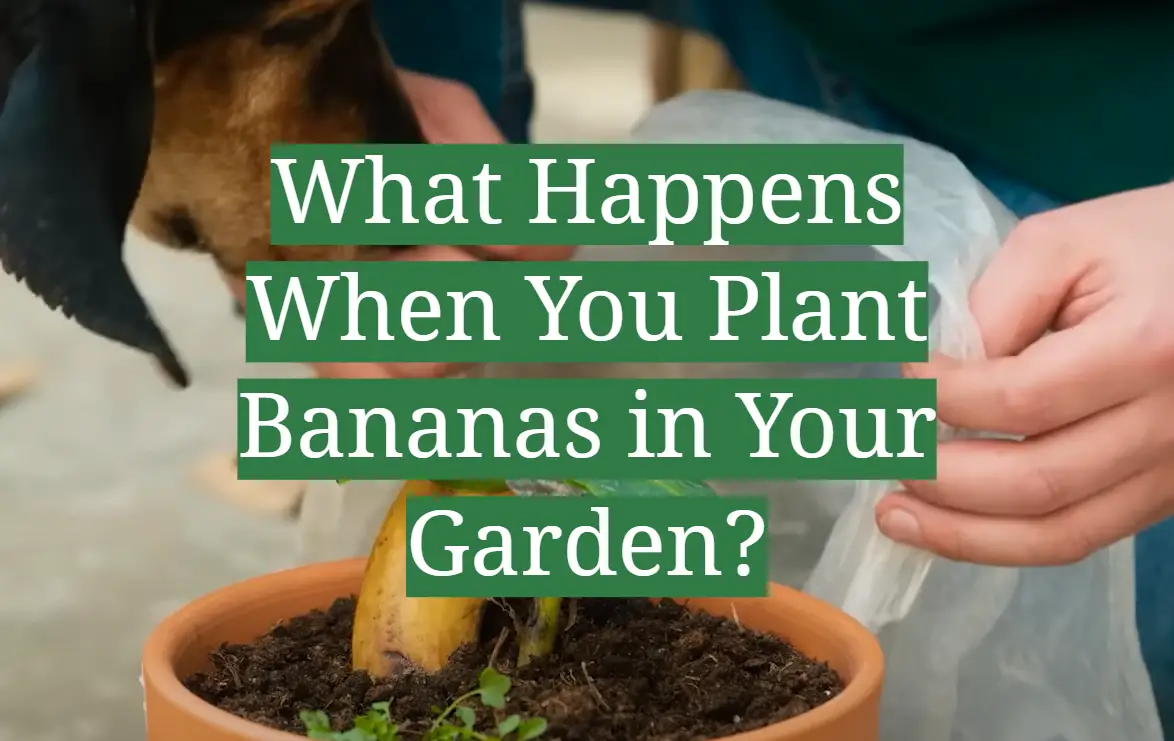Have you ever dreamed of growing your own bananas? Planting and harvesting exotic fruits such as bananas may seem like an unattainable luxury, but in fact it’s surprisingly easy to do! Growing this tropical fruit in your garden or even indoors can provide a nutritious snack and natural refresher for the summer months. But what will happen if you actually take the plunge and plant some bananas at home? In this blog post, we’ll be exploring exactly that – showing you every step of what happens when you decide to grow your own bananas! We’ll look into all aspects of banana cultivation from preparing the soil, planting & watering instructions to tricks on preserving your harvest. So read along to find out just how achievable (and delicious) it is to bring home-grown produce onto our plates.
What You Didn’t Know About Bananas
Bananas are one of the most popular and widely eaten fruits around the world. But there is much more to this yellow fruit than what meets the eye!

Here are some interesting facts you may not have known about bananas:
- Bananas are a great source of potassium and vitamins B6 and C, all of which help to keep your body healthy.[1]
- Bananas have long been known to have a calming effect on the body and mind and can even be used as a natural remedy for insomnia.
- Bananas contain pectin, an important dietary fiber that can help you feel full longer and helps with digestion.
- The average banana is made up of 75 percent water, making it one of the most hydrating fruits out there.
- Unripe green bananas are rich in resistant starch, which can help to keep your gut healthy and happy. [2]
- Bananas can help to reduce inflammation in the body due to their high levels of antioxidants.
- Bananas are a great source of energy and have been known to improve athletic performance when eaten before or after exercise.
- The banana peel has many uses, from soothing skin irritations to being used as an alternative fuel source!
- And lastly, bananas have been linked with many health benefits such as improved heart health, lower blood pressure, and increased energy levels. Who knew all these things were hiding under that bright yellow peel?
Benefits
Now that you know a little bit more about the amazing banana, let’s talk about why you should consider growing your own at home. Here are some of the great benefits of having a banana plant in your garden:
- Growing your own bananas is much cheaper than buying them from the store.
- You have complete control over what type of pesticides or fertilizers you use to grow, allowing you to keep your fruits clean and healthy.
- Homegrown bananas are fresher and taste better than those found in stores.
- You’ll be able to enjoy fruit throughout the entire year, as banana plants can bear fruit all year round! [3]
- Aside from just eating them, you can use the leaves of the plant for a variety of purposes such as crafting or wrapping food.
- Growing bananas at home is an incredibly rewarding experience that will give you a sense of accomplishment like no other!
Overall, there are many great reasons to try growing your own bananas at home. So why not give it a go? All you need is a bit of patience and the right conditions, and before long you’ll be enjoying delicious homegrown bananas straight from your garden!
Varieties
Before we start planting, it’s important to decide which type of banana you want to grow. There are many different varieties out there, each with their own unique characteristics.

Some popular choices include Cavendish, Plantain, and Red Dacca Bananas. Think about the flavor and texture that you prefer when making your selection.
- Cavendish bananas. These are the most popular type of banana, with a sweet flavor and firm texture. They’re perfect for eating raw or in smoothies and desserts.
- Plantains. These green, starchy bananas are a staple in many cuisines worldwide. They’re often cooked and mashed before being served as a side dish.
- Red Dacca Bananas. This variety has an intense sweetness like no other, with a soft texture that makes it great for baking into cakes and muffins. [4]
Now that you know which variety to go with, let’s move on to the next step!
What Banana Plants Like & Dislike
Now that we’ve learned a bit more about bananas, let’s take a look at what banana plants need in order to thrive.
Bananas prefer warm climates and high humidity levels. They do best when grown in full sun and in well-drained soil with plenty of nutrients. You don’t need much space for your banana plants – an area of just 10 square feet is enough to grow a small crop of fruits!
Additionally, fertilizers that contain too much nitrogen can damage the plants – so be sure to use a balanced fertilizer with slow release nutrients.With these essential requirements in mind, you’re now ready to begin growing your own bananas!
How to Grow Bananas in Your Garden
If you want to grow bananas in your garden, there are a few things you need to know.
Planting
Now that you know what conditions are ideal for banana plants, it’s time to get started:
- Begin by preparing the soil in your chosen area. Bananas prefer a mix of sandy and loamy soils with good drainage and plenty of organic matter such as compost or manure. Work this into the top 12 inches (30 cm) of soil and rake it smooth. [5]
- Once you’ve prepared the soil, buy some banana plants from your local garden center or nursery or purchase online. Make sure you pick up enough plants for your desired crop size.
- Plant each banana corm at least 2 feet (60 cm) apart so they have room to spread out when they mature. Dig holes about 1 foot (30 cm) deep, place the corms in, and then cover them with soil.
- Water the plants deeply and regularly during the growing season to keep the soil moist but not soggy. If you live in a particularly dry climate, consider installing an irrigation system to help keep your bananas hydrated.
- Add a layer of mulch around each plant to conserve moisture and reduce weed growth.
- As the plants start to grow and flower, pinch off any shoots that emerge from the base of the plant as these can drain energy away from fruiting shoots.
- Within 12-18 months, you should be able to harvest your first crop of bananas! [7]
Care
Once you’ve planted your banana plants, they will require ongoing care and maintenance. Here are a few tips to keep them healthy and productive:
- Use organic fertilizers such as compost or manure to feed the soil and provide extra nutrition to the plants. This should be done every 4-6 weeks during the growing season.
- Keep an eye out for weeds and remove them as quickly as possible. Mulching can help reduce weed growth as well as conserve moisture in the soil.
- Provide protection from strong winds by tying strings between two stakes near the tops of the plants.
- If you’re growing your bananas in pots, make sure to water them regularly – especially during periods of hot weather. With a bit of care and attention, you can enjoy a bountiful crop of delicious home-grown bananas!
Pests & Disease Prevention
Unfortunately, banana plants can be susceptible to pests and diseases such as weevils, mites, nematodes, and black sigatoka.

[6] However, there are a few things you can do to protect your crop from these common problems:
- Keep the area around your plants free of debris and weeds as these can provide breeding grounds for pests and diseases.
- Practice crop rotation to reduce the risk of infestations or disease buildup in the soil.
- Use organic pest control methods such as insecticidal soaps, neem oil, and BT (Bacillus thuringiensis) sprays to keep pests at bay.
- Consider using a fungicide such as copper sulfate or sulfur to help prevent and treat fungal diseases.
- Check your plants regularly for signs of pests or disease – including mottled foliage, yellowed leaves, stunted growth, and wilting. If you notice any of these issues, take action quickly before the problem gets out of control.
By following these simple tips, you can help ensure that your banana plants stay healthy and productive for many years to come!
How to Grow Bananas Indoors
While outdoor gardening is the most popular way to grow bananas, you can also cultivate them indoors.
Planting
- Start by purchasing a potted banana plant from your local nursery or online.
- Place the pot in a sunny spot near a south-facing window, such as on a windowsill or balcony.
- Add some well-draining soil that is rich in organic matter, such as compost and manure – then water your plant thoroughly.
- While your banana plant is growing, make sure to fertilize it regularly with a balanced fertilizer that contains slow-release nutrients.
- Make sure the soil stays moist but not soggy – water your banana plant every 1-2 weeks depending on how dry the soil is.
- To encourage growth, prune off any shoots that emerge from the base of the plant as these can drain energy away from the main stalk.
- After about 18-24 months you should be able to harvest your first crop of indoor bananas!
Care
In order to keep your indoor bananas healthy and productive, you’ll need to provide them with regular care and maintenance. Here are a few tips:
- Feed your plant every 4-6 weeks during the growing season with a balanced fertilizer.
- Water your banana plant regularly to keep the soil moist but not soggy – you may need to water it more often during periods of hot weather.
- Be sure to rotate your banana plant every few weeks so that all sides receive equal amounts of light and nutrients.
By following these simple tips, you can help ensure that your indoor banana plants stay healthy and productive for many years to come!
Water
Bananas are thirsty plants and require plenty of water to thrive. Here are a few tips for keeping your bananas well hydrated:
- Always water deeply, ensuring that the soil is moist but not soggy.
- Make sure to water early in the morning so that any excess moisture can evaporate before nighttime.
- If you live in a particularly dry climate, consider installing an irrigation system to help keep your bananas hydrated.
- Mulching around the plants can also help reduce water evaporation and conserve moisture.

By following these simple tips, you can ensure that your banana plants stay healthy and productive throughout the growing season!
Light and Temperature Control
Bananas need plenty of sunlight to grow, so make sure your indoor plants are getting at least 6 hours of direct sun per day. During the winter months when days are shorter, you may need to supplement with artificial light.
If your home is too cold for your banana plants, consider setting up a grow light to keep them warm.By following these simple tips, you can help ensure that your indoor bananas remain healthy and productive!
Pruning
Pruning your banana plants on a regular basis can help ensure that they stay healthy and productive. Remove any dead or damaged leaves as well as shoots from the base of the plant to encourage growth. Additionally, you can propagate new banana plants by dividing the rhizome (the underground stem) or taking stem cuttings. Propagating your plants is an excellent way to increase your indoor banana crop!
Harvesting and Storage
Once your indoor bananas are ripe, they can be harvested and enjoyed right away. If you have an abundance of fruit, you can also store them for later use. Bananas can be stored in the refrigerator, where the cool temperature will help preserve their flavor and texture.
By following these simple tips, you can help ensure that your indoor bananas stay fresh and delicious for longer.Propagation
Banana plants can be propagated through the division of the rhizome or by taking stem cuttings. To divide a rhizome, simply dig up your banana plant and carefully separate the underground stems with a sharp knife. You can then replant each section in its own pot. Alternatively, you can take stem cuttings from your existing banana plant and root them in water or soil – this is an easy way to increase your crop!
Is a Banana a Tree or a Plant?
A banana is a perennial herbaceous plant, not a tree. It grows up to 3 – 5m tall and produces a single stem with large leaves and clusters of fruit.
Can You Grow a Banana Tree from Store Bought Bananas?
Yes, you can! All you need to do is find a ripe banana that has not been treated with any wax or preservatives – then remove the peel and place the flesh in water.

After a few weeks, it should start to sprout roots and leaves – at which point it can be transplanted into soil. With proper care, you should eventually have your own home-grown banana tree!
FAQ
How Fast Do Banana Trees Grow?
This will depend on the variety and climate, but typically banana plants can reach up to 15 feet in height within a year or two.
How Long It Takes For a Banana Tree to Bear Fruit?
Again, this will depend on the variety and climate – but typically it can take anywhere from 6-9 months for a banana tree to bear fruit. Good luck! With proper care and maintenance, you’ll have your own home-grown bananas in no time! Enjoy!
Can you eat a banana right off the tree?
Yes, you can! Bananas have a protective outer peel which is edible – so they are safe to eat directly from the tree. The texture and taste may vary depending on the variety, but they should still be quite tasty! Be sure to pick ripe bananas for optimal flavor.
Do Banana Plants Produce More Than Once?
Yes! Once a banana tree has produced fruit, it will usually continue to produce new fruits for several years. However, some varieties may only flower once and then die – so be sure to research your particular variety before planting.
Do All Banana Trees Grow Bananas?
No, not all banana trees produce edible bananas. Some varieties are grown for ornamental purposes only and should not be eaten.
What country do bananas grow best?
Bananas grow best in tropical climates with lots of sun and abundant rainfall. The countries that produce the most bananas are India, Ecuador, Brazil, China, and the Philippines. In these areas, the climate is ideal for optimal growth and production of delicious and nutritious fruits.
Are Banana Trees Good for a Garden?
Yes! Banana trees add a great tropical feel to any garden, and their large leaves provide plenty of shade and protection for other plants nearby. Plus, if you’re lucky enough to get them fruiting, you’ll have delicious home-grown bananas all year round! So why not give it a try?
Can I Plant a Banana Tree Next to My House?
Yes, you can – as long as you take the necessary precautions. Banana trees should be planted at least 8 feet away from your home to avoid any potential damage to the foundation or walls.
Useful Video: How to Grow Banana Tree From Banana 🍌🍌🍌 New gardening method
Conclusions
Planting bananas in your garden can provide you with a delicious, nutritious, and low-maintenance crop. With proper care and maintenance, your banana plants should remain healthy and productive for many years to come! Be sure to keep your plants well watered, properly mulched, and protected from extreme temperatures and light levels. Additionally, prune your plants regularly and propagate them when possible to increase your crop. Finally, harvest and store ripe fruit so that you can enjoy banana goodness all year round! Good luck and happy gardening!
References:
- https://www.healthline.com/nutrition/foods/bananas
- https://www.tsmp.com.au/blog/green-banana-benefits.html
- https://www.allaboutgardening.com/fast-growing-fruit/
- https://goldenspikecompany.com/types-of-bananas/
- https://wikifarmer.com/soil-requirements-and-land-preparation-for-bananas/
- https://www.researchgate.net/publication/297737493_Integrated_Pest_Management_in_Banana
- https://shuncy.com/article/what-season-do-bananas-grow










Leave a Reply
View Comments